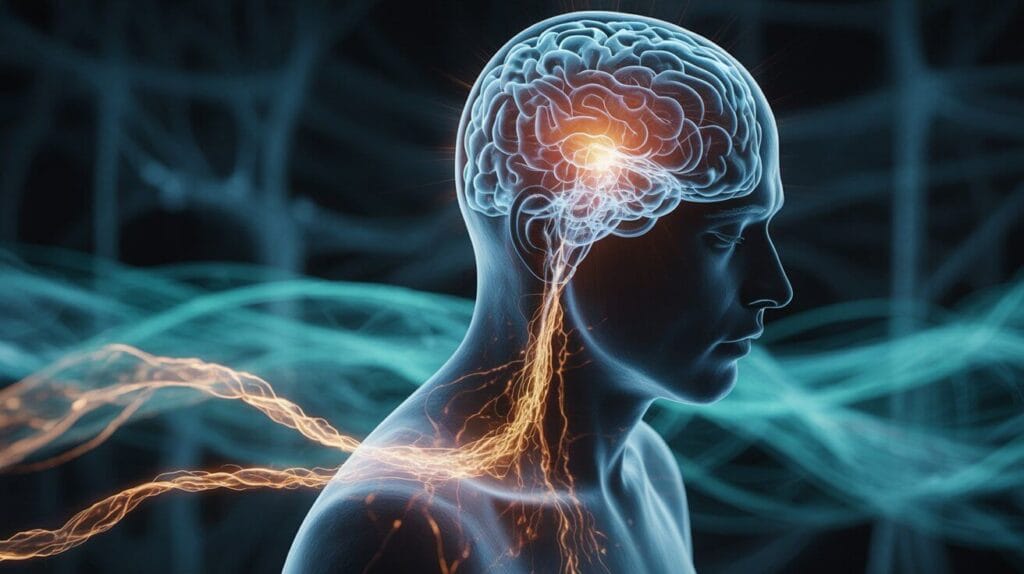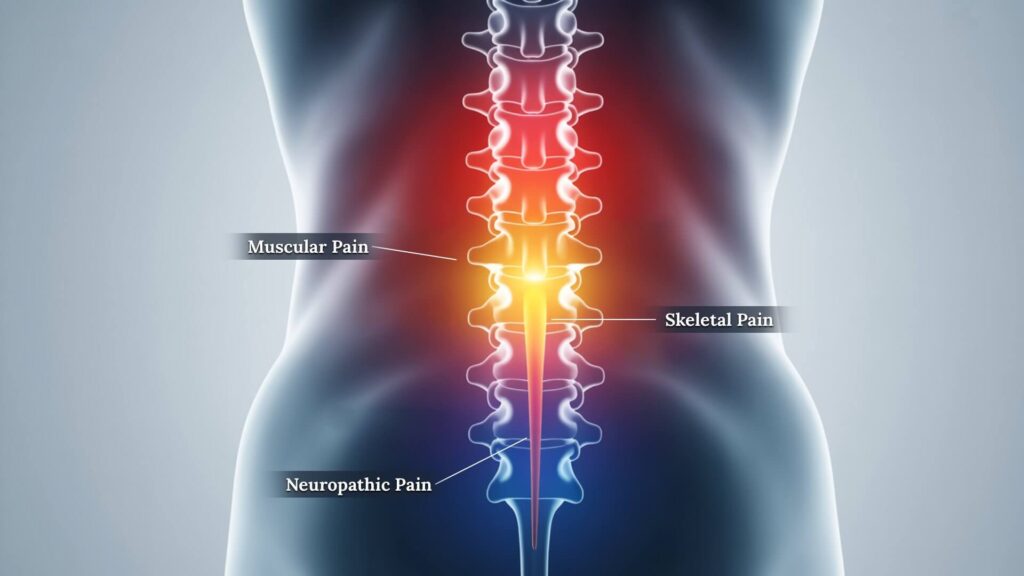The cast is off. The stitches are out. The physical therapist has signed off. By all medical accounts, the injury is “healed.”
So why does it still hurt?
This is one of the most confusing and soul-crushing questions at the heart of chronic pain. It’s a question I’ve explored from both sides—as a physician studying the intricate wiring of the nervous system, and as someone who has personally navigated the bewildering world of pain that overstays its welcome.
If you’re living in this gap between “healed” and “hurting,” you are not broken. Your pain is real. What has changed is not the original injury, but the system designed to protect you: your nervous system. Let’s break down the science of why this happens.
Key Takeaways: Understanding Chronic Pain
- It’s Not Just in Your Head: Chronic pain is a real medical condition where the nervous system itself becomes the source of the pain, long after an initial injury has healed.
- The Cause is Central Sensitization: Your brain and spinal cord become hypersensitive, essentially turning the “pain volume” up and keeping it there. This is why things that shouldn’t hurt, now do.
- The Brain Can Be Retrained: Because the brain can learn to be in pain (neuroplasticity), it can also be retrained to be less in pain through targeted, evidence-based strategies. Understanding this is the first step toward reclaiming control.
Table of Contents
Prefer to Listen? An Audio Overview
For a conversational deep dive into this topic, press play below for the complete audio discussion with our hosts.
Runtime: 4 minutes
View Full Audio Transcript
Narrator: Welcome. Today we’re tackling one of the most common and frustrating questions in all of medicine: “My injury healed months ago… so why am I still in pain?” Dr. Emily, many of our listeners feel lost in this gap. What’s the first thing you want them to understand?
Dr. Emily Richards: The most important thing to know is that your pain is real. You are not imagining it, and you are not broken. What has happened is that the pain has shifted from being a simple warning signal about an injury to becoming a complex condition of the nervous system itself. We’re moving from acute pain to chronic pain.
Narrator: So, what is the fundamental difference between those two?
Dr. Emily Richards: Think of acute pain as a fire alarm. It’s loud, urgent, and serves a clear purpose: it tells you there’s immediate danger—a cut, a sprain, a burn—and you need to react. As the fire is put out, or the tissue heals, the alarm is supposed to shut off. Chronic pain is when that fire alarm is faulty. The fire is out, but the alarm is still blaring. The problem is no longer the fire, but the alarm system itself.
Narrator: That’s a powerful metaphor. The article explains the mechanism behind this faulty alarm is something called “central sensitization.” Can you break that down for us?
Dr. Emily Richards: Absolutely. Central sensitization is the core concept. In my practice, I often describe it as the ‘volume dial’ for pain in your body getting turned all the way up and then getting stuck. Your brain and spinal cord—your central nervous system—become hypersensitive. The nerve pathways that carry pain signals become wider and faster, like a dirt path being paved into a superhighway.
Narrator: And what does that feel like for a person day-to-day?
Dr. Emily Richards: It creates very distinct and confusing symptoms. First, things that shouldn’t hurt, now do. A gentle touch, the pressure of clothing—that’s called allodynia. Second, a small stimulus, like a minor bump, creates a massive pain response. That’s hyperalgesia. And finally, the pain can spread to areas that were never even injured. Your nervous system has essentially learned to be in a state of high alert and is now generating pain all on its own.
Narrator: A lot of people ask what this does to them mentally. How does this constant state of alert affect the brain?
Dr. Emily Richards: It’s a profound connection. The parts of the brain that process pain are physically right next to the parts that process emotion, like fear and anxiety. With a constant stream of pain signals, those connections become incredibly strong. This is why anxiety, depression, and “brain fog” are not just side effects of chronic pain—they are a predictable neurological consequence. It’s a vicious cycle where pain fuels anxiety, and anxiety amplifies the perception of pain.
Narrator: It sounds like a downward spiral. But the article ends with a message of hope based on neuroplasticity. Can this process be reversed?
Dr. Emily Richards: That is the most hopeful truth in modern pain science. Yes. Neuroplasticity means the brain is changeable. If your nervous system can learn to be in pain, it can also be retrained to be less in pain. This is a monumental shift. It means we stop focusing only on the old injury site and start using strategies that calm and retrain the entire nervous system.
Narrator: What kind of strategies are we talking about?
Dr. Emily Richards: We’re talking about evidence-based approaches like mindfulness meditation, which helps decouple the sensation of pain from the emotional reaction to it. We use graded exercise to gently re-introduce movement without triggering the alarm. We focus on anti-inflammatory nutrition to reduce systemic inflammation. These aren’t just coping mechanisms; they are active tools to rewire the brain and turn down that volume dial. It’s about giving you back control.
Narrator: A powerful and hopeful message. Thank you, Dr. Emily.
Dr. Emily Richards: You’re welcome. Understanding is the first, most critical step on the path forward.
From a Helpful Warning to a Chronic Condition: The Great Shift
Acute pain is your body’s alarm system. When you sprain an ankle or touch a hot stove, that sharp, immediate sensation is a vital, purposeful signal alerting you to tissue damage so you can protect yourself. It follows a predictable script: as the injury heals, the pain fades.
Chronic pain is a different entity entirely. It’s not merely a symptom; it is a condition where the pain itself has become the disease. Medically, it is defined as pain that lasts or recurs for more than three months, persisting far beyond the normal healing time for the initial injury. The transition from acute to chronic pain isn’t just about time; it’s about a fundamental rewiring of your nervous system. Imagine the initial injury flipped a switch; with chronic pain, that switch has become pathologically stuck in the “ON” position.
| Characteristic | Acute Pain (A Helpful Alarm) | Chronic Pain (A Faulty Alarm) |
|---|---|---|
| Purpose | Warns of immediate tissue damage or injury. | Serves no protective purpose; the pain itself is the condition. |
| Duration | Short-term; resolves as the injury heals (less than 3 months). | Long-term; persists long after tissues have healed (more than 3 months). |
| Source | Located at the site of the injury (e.g., a sprained ankle). | Originates from a sensitized central nervous system (brain and spinal cord). |
| Treatment Focus | Treat the underlying injury or cause. | Retrain the nervous system and manage the pain condition holistically. |
Central Sensitization: When Your Pain Volume Is Stuck on High
The primary mechanism driving this state is a phenomenon called central sensitization. This is not in your head; it is a very real, documented change in your central nervous system—your brain and spinal cord. Think of it as your body’s entire pain system recalibrating to a state of high alert, becoming ruthlessly efficient at creating the sensation of pain.
This neurological shift creates a vicious cycle with three distinct hallmarks:
- Lowered Pain Threshold (Allodynia): Stimuli that shouldn’t hurt, now do. The light pressure of a bedsheet or a gentle touch can feel abrasive or even excruciating.
- Amplified Pain Response (Hyperalgesia): A minor ache or bump that you might have once ignored now feels disproportionately severe, like a shout instead of a whisper.
- Pain Spreading: The pain begins to bleed beyond its original borders, appearing in other areas of your body that had nothing to do with the initial injury. You can learn more about how to determine the source of your discomfort in our guide to decoding back pain.
Your nervous system has “learned” pain so well that it no longer needs a reason to generate it. This is why treatments aimed solely at the original injury site so often fail—the problem now resides within the processing system itself.
The Brain’s Role: How Pain Rewires Your Emotions
Chronic pain doesn’t just hijack your body; it rewires your brain on an emotional level. The constant barrage of pain signals strengthens the neural superhighways between the parts of your brain that process physical sensation and the parts that govern emotions like fear, anxiety, and depression.
This is a key reason why chronic pain is so often intertwined with these conditions. It is not a sign of personal weakness; it is a predictable neurological consequence of a brain under constant siege. It disrupts your sleep, drains your energy, and clouds your thinking with “brain fog,” further fueling the pain and suffering cycle. This deep interconnection highlights the importance of the mind-body connection in managing chronic conditions.
Reclaiming Control: The Path Forward
Here is the most hopeful truth in all of modern pain science: if your nervous system can learn to be in pain, it can also learn to be less in pain. This concept, known as neuroplasticity, is the foundation of modern, integrative pain management.
Understanding that chronic pain is a condition of a sensitized nervous system—not necessarily a sign of ongoing tissue damage—is profoundly liberating. It shifts the focus from a frustrating search for a “cure” at the old injury site to a proactive strategy of calming and retraining the entire system.
Approaches like mindfulness meditation, graded exercise, physical therapy, anti-inflammatory nutrition, and cognitive behavioral therapy are not just “distractions.” They are evidence-based techniques designed to directly target central sensitization. They work by quieting the overactive nerve pathways and turning down the volume on the pain signals, empowering you to become an active participant in your own relief.
This understanding is the true beginning of your journey. It’s the first step to seeing your pain not as a life sentence, but as a condition that you can learn to manage, influence, and ultimately, live well with.
Frequently Asked Questions
How long do you have to have pain before it’s considered chronic?
Medically, pain is generally considered chronic when it persists for more than three to six months, which is longer than the normal expected time for an injury to heal. The key distinction is that it’s no longer just a symptom of tissue damage but has become a condition of the nervous system itself.
What is the difference between neuropathic pain and chronic pain?
“Chronic pain” is a broad term for any pain that lasts over three months. “Neuropathic pain” is a specific type of chronic pain caused by damage or disease affecting the nervous system. It often feels like a burning, shooting, or electric shock-like sensation. While not all chronic pain is neuropathic, much of neuropathic pain is chronic.
Can chronic pain ever go away?
While a complete “cure” isn’t always the primary goal, significant, lasting relief is absolutely possible. The focus of modern integrative pain management is to “turn down the volume” on pain by retraining the brain and calming the nervous system through evidence-based strategies like physical therapy, mindfulness, and anti-inflammatory nutrition. Many people learn to manage their pain so effectively that it no longer controls their lives.
Disclaimer: The content provided by Dr. Emily Richards is for informational and educational purposes only and does not constitute medical advice. Always consult with your healthcare provider for any health concerns or before making any changes to your treatment plan.
References
View Full List of Scientific References
- Raja, S. N., Carr, D. B., Cohen, M., Finnerup, N. B., Flor, H., Gibson, S., Keefe, F. J., Mogil, J. S., Ringkamp, M., Sluka, K. A., Song, X. J., Stevens, B., Sullivan, M. D., Tutelman, P. R., Ushida, T., & Vader, K. (2020). The revised IASP definition of pain: concepts, challenges, and compromises. Pain, 161(9), 1976–1982. https://pmc.ncbi.nlm.nih.gov/articles/PMC7680716/
- Latremoliere, A., & Woolf, C. J. (2009). Central sensitization: a generator of pain hypersensitivity by central neural plasticity. The Journal of pain, 10(9), 895–926. https://pubmed.ncbi.nlm.nih.gov/19712899/
- Apkarian, A. V., Bushnell, M. C., Treede, R. D., & Zubieta, J. K. (2005). Human brain mechanisms of pain perception and regulation in health and disease. European journal of pain, 9(4), 463–484. https://pubmed.ncbi.nlm.nih.gov/15979027/
- UW Health. Central Sensitization. Updated May 2024. Accessed August 29, 2025. https://patient.uwhealth.org/healthfacts/8119
- Jensen TS, Finnerup NB. Allodynia and hyperalgesia in neuropathic pain: clinical manifestations and mechanisms. Lancet Neurol. 2014 Sep;13(9):924-35. doi: 10.1016/S1474-4422(14)70102-4. PMID: 25142459.
- Gwilym SE, Filippini N, Douaud G, et al. Neuroplasticity in chronic pain: insights into diagnosis and treatment. Front Neurol. 2024;15:1324329. doi: 10.3389/fneur.2024.1324329. PMID: 38903005; PMCID: PMC11965994.
- Kennedy J, Norman I, Smart KM, et al. The Revised IASP Definition of Pain and Accompanying Notes: Considerations for the Physiotherapy Profession. Physiother Can. 2021;73(3):229-233. doi: 10.3138/ptc.2020-60. PMID: 34335660; PMCID: PMC8370731.
- Almeida C, DeSantana JM, Kennedy J, et al. Chronic Pain: Structural and Functional Changes in Brain Structures and Associated Negative Affective States. Front Neurosci. 2019;13:898. doi: 10.3389/fneuro.2019.00898. PMID: 31427812; PMCID: PMC6650904.

Start Healing from the Inside Out
Download my FREE 7-Day Anti-Inflammatory Kickstart Guide. It’s a simple, doctor-designed plan to help you reduce inflammation and soothe pain, one meal at a time.


